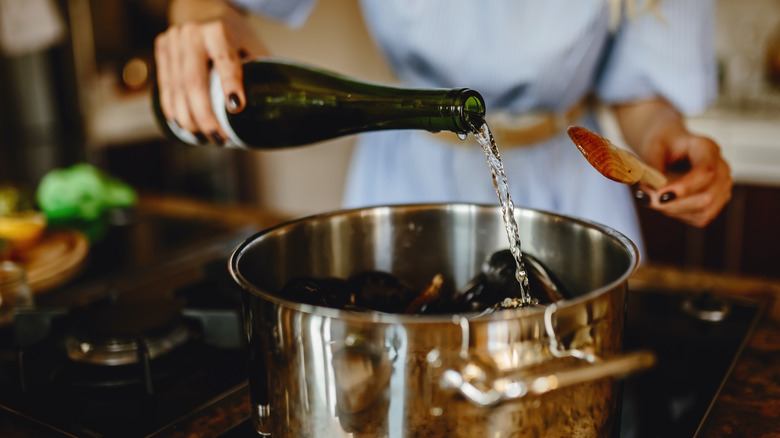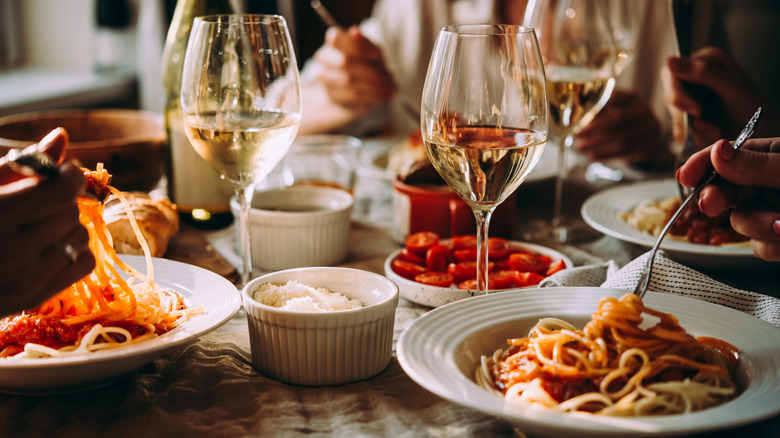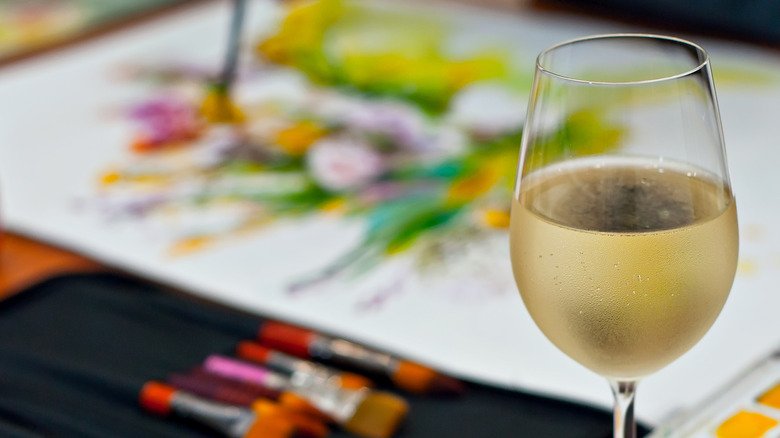The Best Type Of White Wine For Cooking
While grandma might have had that dusty bottle sitting on the counter, many home cooks have learned that cooking wine is not necessarily a highly regarded beverage category. Although there are wine bottles that are labeled just for cooking, the shelf-stable offerings might not add the flavor that chefs desire. As Usual Wines shares, any wine can be used when crafting a recipe as long as it adds complementary flavors to a dish. Just like mashed potatoes are better with cream versus lemon juice, flavor balance should always guide that beverage pour.
Choosing a wine for cooking can be more confusing than finding a bottle for that next movie night. While some people might just use the leftover splash from the bottle that was not finished on Friday night, not all wines offer the same flavor enhancement. Just like few wine drinkers would pair a lamb chop with a Riesling, adding a merlot into shrimp scampi is probably not advised. When choosing a white wine for cooking, it's best to think about the type of wine and how it will impact the overall flavor of a dish.
Not all white wines should get poured into the pot
While white wine can make a wonderful flavor enhancer or even pan de-glazer, cooks should not just grab any bottle and pour. Choosing the right white wine is just as important as carefully chopping, dicing, and mincing those ingredients. According to Wine Pro Club, dry white wine is often preferred for cooking. One of the primary reasons is that this style of wine often has less sugar. A sweet wine can help with caramelization, but it can also cause burnt qualities, which can be acrid. In addition, a dry white wine can bring acidity to a dish. Sometimes a punch of acid can balance all the other flavors and round out the recipe.
Although some people enjoy a chardonnay, some cooks prefer to keep that style of wine out of the pan. Since some chardonnay wines are oaked, that robust flavor can overwhelm the other ingredients in a recipe. In addition, the oak quality can occasionally cause bitterness, which can be an unpleasant taste.
A simple rule to remember when cooking with white wine is that dry is just fine. Still, finding that perfect dry white wine that will enhance the dish might require a few bottles to be uncorked.
Dry white wines to pour both in the pan and in the glass
After determining that a dry white wine is preferred for cooking, picking that bottle needs a little more discussion. According to Wine Spectator, a dry wine generally has less sugar. Although this concept can apply to a variety of styles, the most common wines that are usually considered dry are Sauvignon Blanc and Pinot Grigio, as well as some other regional offerings.
Although there are varietals from across the globe, the most well-known Sauvignon Blanc wines are from France and New Zealand. As The Wine Buying Guide says, this wine often has fresh, crisp notes. From green apples to fields of grass, it's almost spring-like with a zestiness that captivates on a bright day.
Thinking of a Pinot Grigio? VinePair asserts that the approachability of this wine lends itself to its popularity. Drinkers can almost taste the bright acidity of a good Pinot Grigio before it hits the lips. Although this category can be full, it's worth trying various bottles to discover one that appeals to personal preference.
Even though dry white wine might be the better choice for cooking, one guiding principle should be considered before anything is added to the recipe. If a person would not drink it from their wine glass, the wine should not be poured into the pan. That cooking advice is a sentiment worthy of any toast around the table.


